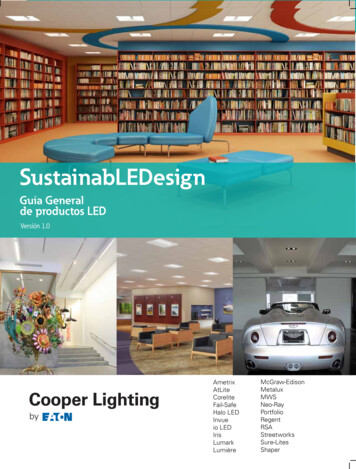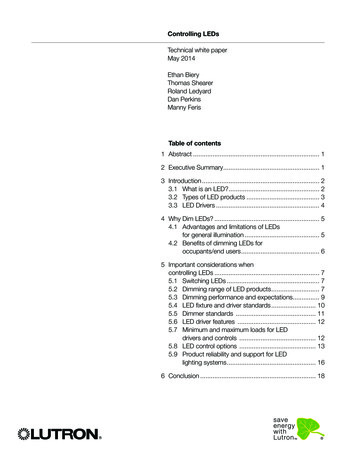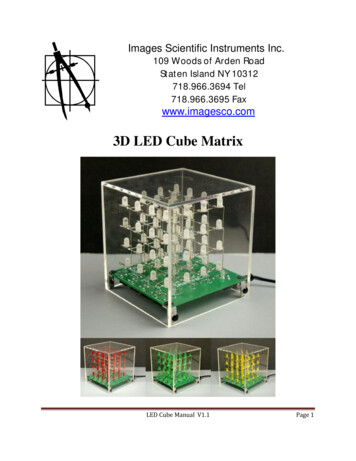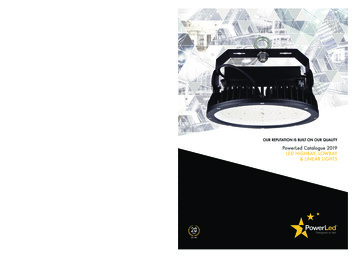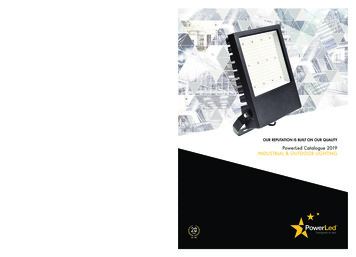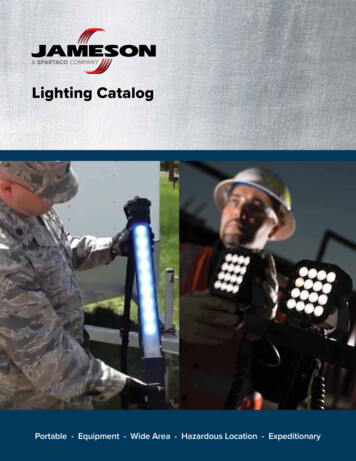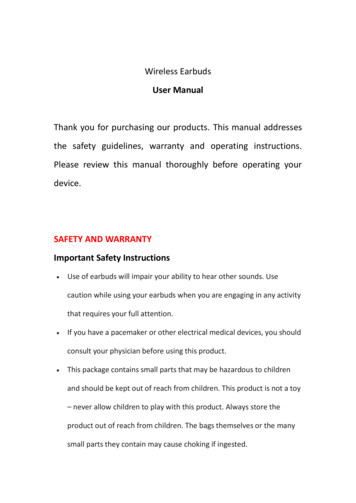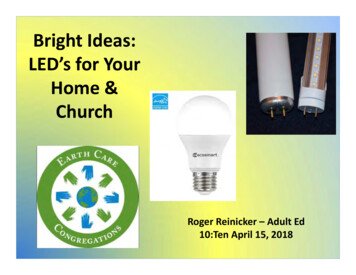
Transcription
Bright Ideas:LED’s for YourHome &ChurchRoger Reinicker – Adult Ed10:Ten April 15, 2018
Earth Care Congregation “Earth Care Congregation” is acertification from PC(USA) Church exhibits leadership in protectingGod’s creation and are good stewards ofearth’s resources via:WorshipEducationOutreachAdvocacyFacilities Management WPC has been certified for 9 years Only 2 % of the 10,000 Presbyterianchurches have passed certification
OUTLINE Light and Color What are LED’s? Choosing the right LED for your home LED’s at Westminster
New Terms to Learn LEDLumensLuminous efficacyBeam angleTrofferLuminaireCRIColor temperatureT12, T8Plug and PlayA19, A21 etc.tombstone
FUNDAMENTALSOF COLORLightSourceMust haveall three tohave theperceptionof color!ObjectObserver
And God said, “Let there be light,” and there was light. God sawthat the light was good, and he separated the light from thedarkness.
Light The light that the Creator gave us is a littlecomplicated! The light includes ultraviolet light (UV – whichis why we wear sunscreen) and infrared lightor heat
The Electro‐magnetic Spectrum90Visible spectrum400nm - 700nm804030UVA 320nm – 400nm%R50UVB60290nm – 320nm70Near infra-red700nm – 2500nmHEAT!20100290290400700Wavelength, nm2500
Color In the preceding slide, the black linerepresents the wavelengths of light reflectedby an object back to our eyes. Since the reflected wavelengths are blue andred (more red than blue) the object is a blueshade red (or magenta) color.
LED Light Emitting DiodeA slide forGeeks!
Hand out diodesAs you receive your LED notethat it has two wire leadsand one is longer than theother. This is to discriminatebetween and the positiveand negative sides of thediode. Electricity only flowsone way through a diodehence it requires “directcurrent” not “alternatingcurrent”.
SMALL BUT MIGHTYThis diode came from a Christmas light set and wasphotographed in transmitted and reflected lightReflective cavity 0.066 inches(1.67 mm) diameterInternal wire is 75% thinner than atungsten filament (0.036 mm)
Show Hyperikon lightdiodesFluorescentT12 lightHyperikonbrand LEDlightThe Hyperikon light arranges the diodes light like little flashlights in a line.
LIKE FLASHLIGHTS IN A LINE
LIKE FLASHLIGHTS IN A LINElenslensSome LED bulbs use alens to spread out thelight in a wider beamangleBeamangle
LIKE FLASHLIGHTS IN A LINEphosphorScattered lightSome LED bulbs use aphosphor coating onthe inside of the bulb tospread out the light
Show Christmas Light Christmas string lights use a simple method tocreate the right voltage and current required bythe diode. Light actually flashes 60 times per secondbecause only ½ the wave of the AC is used.AC sine wave
Incandescent and CFL lights Incandescent light bulbs create light by heating afilament inside the bulb; the heat makes the filamentwhite‐hot, producing the light that you see. Halogenlight bulbs create light through the same method.Because incandescent and halogen bulbs create lightthrough heat, about 90% of the energy used is wastedto generate heat. Fluorescent light bulbs use an entirely differentmethod to create light. Both compact fluorescent lightbulbs and fluorescent linear tubes only wasteapproximately 30% of their energy in heat, makingthem far cooler and more energy efficient than regularbulbs.
Incandescent and CFL lights Incandescent light bulbs ‐ 90% Heat Fluorescent light bulbs ‐ 30% Heat– Require a ballast to convert energy– Ballast consumes energy and generates heat LED’s ‐ very little heat
SPECTRA OF BULB TYPES
Comparison of BulbsAll three lights give aboutthe same amount ofillumination measured inlumens.ComparisonWattscolor temperatureLumensLifetime yearsenergy cost/yrpriceIncandescent602700K7201.4 7.23 1.46CFL132700K8009.1 1.57 1.64LED92700K80010 1.08 1.88
Throw Away Your Incandescent Bulbs! The previous slide shows how cost and energyefficient LED bulbs have become Lifetime is predicted on 3 hours per day andcost is based on 11 cents per kilowatt hour That means you get a 300% return on an LEDbulb* (vs. an incandescent) in 1 year!* For the bulb price and lumens listed in the chart
Watts vs. Lumens Previous technology: more watts more light But would you buy a car based only on howmany gallons of gas it used per hour? New technology: buy lights based on lumens What is a lumen?– Lumen is luminous flux or a measure of the totalquantity of visible light
Watts to LumensLED Watts Old Watts/7
LED Disadvantages Absolutely no good for– Lava lamps !– Easy‐bake toy ovens !– Fruit dehydrators !– Real ovens (LED have enclosed electronics)– Some tightly enclosed lighting fixtures (LED’s stillgenerate a small amount of heat – but the makerwill indicate if this is or is not an issue)
LED advantages Little heat generated– Saves energy– Saves on cooling costs, too Low energy use – high efficacy or efficiency– Lumens per watt up to 100!
LED advantages Instantly on at full brightnessBetter at handling vibration; not easily brokenContain no mercuryNever “burn out” just get dimmer– Longevity based on retaining 70% brightness Low temperature performance– Unlike CFL’s which are rated only above freezing Dimmable Any color you want
LED advantages No UV radiation!– won’t attract bugs!– won’t damage art work!
Hand Out Bulbs
Let’s Look at the LED BoxStarthere
About This Bulb This bulb cost 1.88 at Home Depot The FCC warning statement is standardrequired for electronics ‐ including kids’ toys It is an A19 bulb meaning your averagestandard bulb size and shape It is good for floor lamps, table lamps, ceilingfans, sconce lights, and hanging lights It can be totally enclosed
Color Temperature 2700K ‐ warm, yellowish white4100K ‐ bright white5000K ‐ bluish white6500K ‐ daylightCommon LED colors include amber, red, green,and blue. To produce white light, different colorLEDs are combined or covered with a phosphormaterial that converts the color of the light to afamiliar “white” light used in homes.
Color Temperature 2700K ‐ warm, yellowish whiteLiving room for aninviting ambienceBedroom for a relaxingsetting
Color Temperature 4100K ‐ bright whiteKitchen for foodpreparationLaundry room forseeing stains
Color Temperature 4100K – 6500K ‐ bright or bluish whiteBathroom for applyingmakeup or shaving – alsochoose a bulb with a CRI of atleast 90
What is CRI? CRI is “Color Rendering Index” Color rendering describes how a light sourcemakes the color of an object appear to humaneyes and how well subtle variations in colorshades are revealed. The higher the CRI, the better the colorrendering ability. Light sources with a CRI of85 to 90 are considered good at colorrendering.
Are LED’s Dimmable?LIKE A GOODMARRIAGE!Must have goodcompatibilitybetween the lightand the dimmercontrol – like amarriage!
Dimmability LED’s are dimmable but cost a little bit more I find that the current dimmer switches in myhouse don’t work as well with LED’s LED lights on old dimmers don’t dim smoothly LED’s require so much less power, olderdimmer switches don’t work well Buy a newer good brand of dimmer made forLED’s and a good brand of LED bulb as well
LED’s at Westminster
LED’s at Westminster‐‐‐‐‐‐1.5 in.‐‐‐‐‐ Opportunity was identified by an Energy Auditin August of 2016. Replace T12’s!T tubular, 12 x 1/8” 1.5 inch diameter
We Did A Survey
Lots of Lights! Inventory revealed over 1600 inside lights andat least 22 varieties– Incandescent, including dimmable– Quartz– Halogen– Fluorescent; tubular and CFL– LED’s in sanctuary, Rowell CR– Heat lamps
T12’s need Magnetic BallastsAlmost all fluorescentlights in Westminsterwere: Four foot T12, 1.5inches diameter Powered by magneticballasts
Some Considerations With T12 being obsolete we could go severaldirections– Replace with T8 or T5 fluorescent ‐ but would requirepurchase of new ballasts; still use Hg– Replace with Plug and Play LED T8 diameter bulbs –but then have to keep the obsolete and energy eatingballasts– Remove ballasts and go with direct wire LED bulbs
We Did Light TrialsLUX @ Table Height700600500Instafitrequirea ballastLED lights in blue, fluorescent in beigeInstafit 17W LEDInstafit 15W LED400Sylvania 40W FLToggled 16W LEDSATCO 15W LED300SATCO 15W LEDSATCO 15W LED200LUXRITE 22W LEDPhilips 34W FL100Hyperikon 18W LEDPhilips T8 FLPhilips T8 FL0
Typical Savings in Each Troffer T12 Fluorescent – 4 ft plus ballast– 3 bulbs x 34 watts ballast energy about 106W T8 LED ‐ 4 ft ‐ direct wire, ballast removed– 2 bulbs x 12.5 watts 25 watts– Savings of 76%
Getting the Grant from DNREC Power billsCurrent lightingLighting layoutsRoom sizes DLC qualified Action plan Insurance etc etc
Lights by the numbers:49 rooms & hallways664 T12 bulbs removed403 ballasts removed436 new LED bulbs installedPhixIt CrewPaul Crothamel (Staff ‐ Director ofFacilities and Security)Jeff LippincottRich AlbertJerry FedelerMark MosherWayne SparlingRoger ReinickerSteve JohnsonFred NelsonJim Carter
Replacing the lastT12 in the projectin the main hall byreception.
Ballasts Headed for RecycleWe received 0.15per pound from therecycler
Project Cost & Return Return on investment Originally we calculated about 2 years However, bulb prices were less and also theDNRec grant will be lower Costs Bulbs ranged from 7 to 13 each We bought 476 bulbs for 4,549.47 Installation was free (PhixIt) Disposal of old bulbs cost 259.50 Recycling of ballasts returned 185.00
Questions?
bulbs and fluorescent linear tubes only waste . Buy a newer good brand of dimmer made for . SATCO 15W LED SATCO 15W LED SATCO 15W LED LUXRITE 22WLED Philips 34W FL Hyperikon 18W LED Philips T8 FL P
